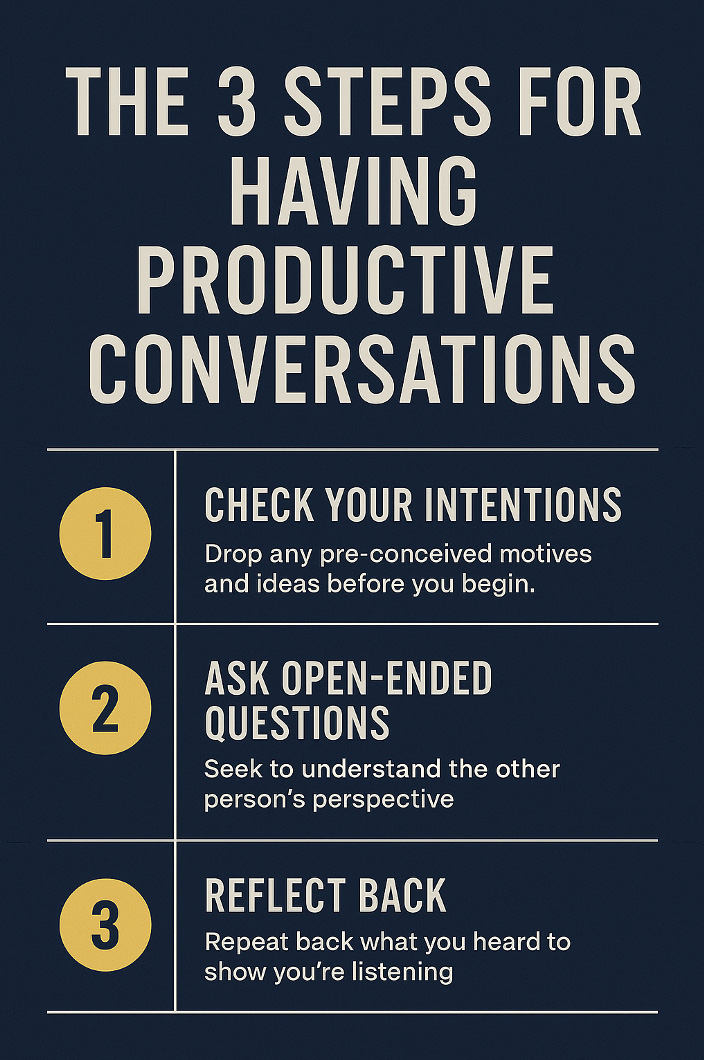Coming in Hot
Let’s get one thing straight—most managers screw up tough conversations because they come in hot.
Loaded with assumptions. Armed with conclusions. Dead set on being right.
Big mistake.
Because the second you walk into a conversation thinking you already know what the other person’s going to say—or what they should say—you’ve already lost. You’re not having a conversation. You’re running a monologue in your own head.
And guess what? That’s not leadership.
If you’re a manager who wants to actually influence, not just talk—then you need a real skillset for navigating difficult conversations with your direct reports, your peers, and yes, even your boss. Let’s break it down.
The #1 Mindset Shift: Ditch the “Intention Invention”
Here’s the poison pill that kills productive dialogue: pre-loaded perception.
You invent an intention, assign it to the other person, and then react to the story you made up in your own head. That’s emotional landmines 101.
Instead:
- Assume you don’t know the full story (because you don’t)
- Assume they have a perspective worth hearing (because they do)
- Make it your job to discover, not declare
Use Jefferson Fisher’s 3-Step Framework.
If you want the conversation to stay productive and not spiral into a finger-pointing match, use this setup:
- Tell them what you want to talk about. Set the stage. Let them know what the topic is and why it matters.
- Tell them how you want the conversation to end. This isn’t manipulation—it’s clarity. Whether it’s understanding each other better, agreeing on a next step, or simply hearing both sides, say it upfront.
- Get their buy-in before it begins. Ask: “Does that work for you?” You create alignment before diving in.
Here’s what that might sound like in real life:
“Hey, I’d like to talk about how the last project wrapped up, specifically around deadlines and communication. My goal here is for us to both walk away understanding what went wrong and what we can do better moving forward. Are you okay having that conversation right now?”
Now you’ve got direction. Now you’ve got consent. Now you’re leading.
The 3-Step Framework for Listening Like a Leader
Once you’ve set it up, use this to keep it productive:
- Mirror Repeat back what you hear. Not what you think you heard. Use their words.
- “What I hear you saying is…”
- “Let me make sure I understand…”
- Validate You’re not agreeing—you’re acknowledging their reality.
- “That makes sense given what you’ve experienced.”
- “I can understand how you’d feel that way.”
- Guide Now and only now, steer the ship.
- “Would you be open to looking at it from this lens?”
- “Can I share what I’m seeing from my side?”
Arguments Are for Losers (Even If You Win)
Think you scored a win because you cornered someone with facts? Congrats, you just lost their trust.
Arguments feel good in the moment—especially when you think you’re right—but they’re emotional grenades that blow up long-term respect. Nobody likes being proven wrong in front of others. Or even in private.
So, do this instead:
- Ask more questions than you make statements
- Say, “Tell me more” instead of “That’s not true”
- Check your tone. If your voice tightens, you’re in the red zone

Control the Only Thing You Can: Yourself
If the other person comes in hot—agitated, emotional, maybe even rude—you do not match their energy.
You de-escalate. That’s leadership.
Here’s how:
- Speak softer. Literally. Lower your voice.
- Name the emotion. “Sounds like this has really frustrated you.”
- Pause. Silence creates space. Space cools heat.
When you stay grounded, they’ll eventually come down to your level. Not because you told them to, but because you modeled how to.
Don’t Lose Your Cool—So You Never Have to Apologize Again
One of the biggest wins of using this approach? You don’t blow up and say something stupid you regret later.
You stay calm, centered, and clear.
This isn’t about weakness. It’s about strength under pressure. And the more you practice it, the more respect you earn.
When They’re Flat-Out Wrong
What if you know they’re wrong?
You still don’t come in like a wrecking ball.
Try this:
- “That’s an interesting take—walk me through how you got there.”
- “I want to understand your logic, even if I see it differently.”
- Once they feel heard, guide: “May I share what I’ve seen that might shift how you’re viewing this?”
It’s not about winning—it’s about leading them to clarity.
Real-World Scripts for Tough Talks
With a Direct Report: “Hey, I noticed the deadlines have been slipping. I don’t want to jump to conclusions—can you walk me through what’s happening from your side?”
(Mirror) “So it sounds like you’ve been overloaded since we restructured. That’s a lot to handle.”
(Validate) “Let’s figure out how we can get ahead of this so deadlines aren’t an issue moving forward. Here’s one idea—would that work for you?”
(Guide)
With a Peer: “I got the sense from our last meeting that we might not be aligned on the project direction. Want to walk through where we’re both coming from?”
“Makes sense that you’d push for speed—it’s your KPI. I’m watching for accuracy, so I think that’s where we’re clashing.”
“Let’s find the overlap so we don’t burn time chasing two goals.”
With a Boss: “I wanted to run something by you—I’ve noticed a few challenges with how the team’s prioritizing things, and I’m wondering if I’m missing something in how you’re seeing the bigger picture.”
“That perspective helps a lot. I wasn’t seeing how that initiative tied to the broader goals.”
“Would it be helpful if I aligned our next steps a little closer with what you’re pushing at the exec level?”
Bring the Heat Down
Here’s how to bring someone back from the edge:
- “I can see this really matters to you. Let’s figure it out together.”
- “I’m not here to fight—I’m here to understand.”
- “You’ve got my full attention. Let’s take this one step at a time.”
Avoid these trigger phrases:
- “Calm down”
- “You’re overreacting”
- “That’s not what happened”
Instead, use words like:
- “Let’s take a breath”
- “Help me understand”
- “I want to hear your full side”
Famous Leaders Who Mastered the Art
Dwight D. Eisenhower was known for his calm demeanor and ability to keep competing personalities in check during World War II and his presidency. He made time to listen and used strategic silence to defuse tension.
Abraham Lincoln navigated one of the most divided periods in American history by listening deeply, telling stories, and diffusing conflict with empathy and logic.
Steve Jobs, despite his intensity, had moments where he’d pause and reflect during feedback sessions, asking just the right questions to spark breakthroughs from his team.
Bottom Line
- Don’t walk into a conversation to win. Walk in to learn.
- Don’t talk to prove a point. Talk to understand one.
And if you want a deeper dive on how to lead these conversations without stepping on a landmine, grab my free e-book:
Download the Free EBook
The Road Map to Difficult Conversations
You’ll never look at leadership the same way again—and you’ll never have to say, “I’m sorry I lost my temper” again either.
That’s not just better management. That’s real power.
Ready to start having conversations that drive real change? Start practicing today. The next time someone pushes your buttons, pause and lead instead.







